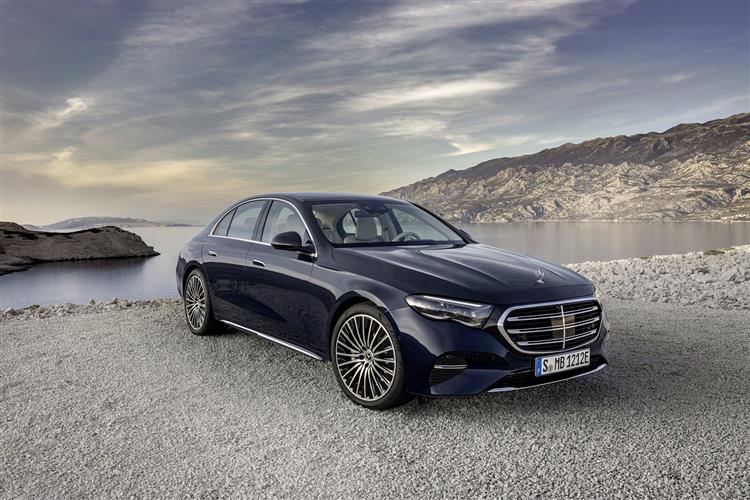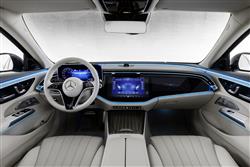E-FORMATTED (some text hidden) --NONE--
By Jonathan Crouch
There's plenty of life left in the E-Class model line, as this sixth generation design proves. Jonathan Crouch drives it.
Ten Second Reviewword count: 104
Cars are rarely as crucial to their makers or buyers as this E-Class model is to Mercedes. This full-sized Executive segment contender is the backbone of the German company's range and a perennial favourite of the corporate car park. This sixth generation W214-series model retains a sensible side but dials up the desirability, aiming to offer a smarter, more prestigious approach to Executive class motoring than close competitors. It does so with more efficient engines, cutting-edge drive technology and comfort that makes you question the need for a larger luxury saloon. Arch-rivals from Audi and BMW still have quite a benchmark to aim at.
Backgroundword count: 185
Over a history going back more than 75 years, the E-Class and the models it's derived from have been at the heart of the Mercedes range. Today, there's a similarly-sized all-electric E-Class alternative in Mercedes showrooms, the EQE. But the Stuttgart maker remains committed to its core combustion luxury model, as evidenced by the depth of development that's gone into the sixth generation W214-series E-Class we look at here. According to the Three-Pointed Star, this is 'the most personal Mercedes ever', able to sense what you want even before you know you want it, be that media tech, cabin climate or drive dynamics. Much of course, including certain styling elements, is borrowed from the larger S-Class, though as usual, unlike that car, the 'E' can also be had as an estate. And of course it needs to be good, hitting the market at much the same time as new generation versions of its two arch-rivals, the BMW 5 Series and the Audi A6. To take on those two, this MK6 E-Class needs to be more than just an evolutionary step forward. Is it? Let's see.
Driving Experienceword count: 819
This sixth generation E-Class offers a selection of combustion powerplants defiantly still including two formats well out of industry favour, diesels and a diesel PHEV. We actually tried a diesel E-Class for this test, the 197hp 2.0-litre four cylinder E 220 d, which like all mainstream E-Class engines is a 48V mild hybrid and gets offered in the UK only in conventional rear-driven form. Throughout our test, this unit served to remind us just what a good fit a great diesel still is on a car like this, wafting around on 440Nm of torque and easing through the perfectly-spaced ratios of the smooth-shifting 9-speed auto that all variants of this car must have. There's the usual set of Dynamic Select drive modes and in 'Sport', the most urgent of these, 62mph is 7.6s away en route to 148mph. If you want an E-Class diesel with the brand's now improved 4MATIC AWD system, as towers might, you'll need the six cylinder 3.0-litre E 450d 4MATIC. This makes 62mph in 4.8s en route to 155mph and, more significantly, has 750Nm of torque, more effortlessly delivering the 2,100kg braked towing weight that all variants of this car share. The other mainstream E-Class engine is petrol-powered, the entry-level 204hp 2.0-litre four cylinder unit found in the base E 200 model. On paper, it's fractionally faster than the equivalent diesel (62mph in 7.5s and 149mph) but in reality feels quite a lot slower thanks to 120Nm less pulling power. Pulling power won't be in short supply if you opt for one of the PHEVs; there are two, the petrol E 300 e and, as mentioned earlier, unusually a diesel PHEV too, the E 300 de. They're based on the 2.0-litre petrol and diesel units we've just briefed you on but add a 125hp electric motor to the mix, energised by a 25.4kWh battery capable of nearly 70 miles of EV range. Total system output in each case is 313hp and 0-62mph in either model takes 6.4s on the way to a maximum of around 146mph. We can't help thinking right now that for most executives most of the time, an E-Class Plug-in Hybrid is a better all-round confection than the brand's equivalent all-electric EQE saloon - and the PHEV E-Class also has the advantage that it can also be ordered as an estate. Which is a body shape you might want for reasons other than carriage capacity. Unlike the E-Class Saloon, the station wagon version comes with rear air suspension as standard. Which you'll appreciate because, rather unwisely, Mercedes has decided that in standard form, the E-Class should come with quite a firmly-suspended 'Sport' version of its Agility Control suspension. And, to be frank, despite built-in selective damping, that doesn't deliver the kind of floaty, cossetting ride this Mercedes ought to have. To address that oversight, it's necessary to add the expensive optional 'Refinement package' that's been fitted to this test car, standard-fit only on the E 450 d. With this, you get all-round AIRMATIC air suspension and full adaptive damping with automatic level control, all enough to restore the magic carpet-like ride you'd want this car to have. With the 'Refinement package', Mercedes also throws in its latest rear-axle steering system, which turns the rear wheels by up to 4.5-degrees, adding extra cornering stability at speed and when manoeuvring, reducing the turning circle by up to 90 centimetres. Though it's not our focus here, we should also say a few words about the only E-Class variant we haven't yet mentioned, the Mercedes-AMG E 53 HYBRID 4MATIC+. In one hit, this replaces two W213-era AMG models, the previous E 53 (a mild hybrid) and the classic E 63 (a wildly powerful V8). Instead, for this W214-era E 53 there's a six cylinder 3.0-litre petrol PHEV drivetrain, which uses a 21.2kWh battery energising a 163hp electric motor sandwiched between the engine and the AMG Speedshift TCT 9G auto gearbox. Total system output is 569hp, 158hp down on the G90-era BMW M5 Stuttgart wants this top variant to compete with (also now a PHEV), though the 3.8s 0-62mph time of the Mercedes is just 0.3s slower than that Munich model - and it goes considerably further (up to 60 miles) on battery power. The same 2.0-litre engine also features in the E 300e Plug-in petrol model, which offers 312bhp and now gets a larger 25.4kWh battery capable of taking the car up to 69 miles without troubling combustion power. Also a PHEV is the top Mercedes-AMG E 53 HYBRID 4MATIC+ model, which can offer up to 603hp, has up to 59 miles of EV range and can get to 62mph in just 3.8s. Whatever mainstream E-Class you decide upon, your dealer will want you to consider the pricey optional 'Technology Pack', which adds AIRMATIC air suspension and a rear axle steering system that can add 4.5-degrees of turning angle, reducing the turning circle to just 10.8m.
To see the full road test text contact us on 0330 0020 227
Pictures (high res disabled)

.jpg)
|
.jpg)
|
.jpg)
| |||
.jpg)
|
.jpg)
|
.jpg)
| |||
.jpg)
|
.jpg)
|
.jpg)
| |||
.jpg)
|
.jpg)
|

|
Statistics (subset of data only)
Min |
Max |
|
Price: |
£56,650.00 (At 7 May 2025, E 200 AMG Line) |
£100,245.00 (At 7 May 2025, E 53 Estate Night Edition Premium Plus) |
CO2 (g/km): |
158 (E 450d 4MATIC) |
11 (E 300 de) |
Max Speed (mph): |
147 (E 300e) |
155 (E 450d 4MATIC) |
0-62 mph (s): |
7.5 (E 200) |
3.8 (E 53) |
Electric WLTP-Rated Driving Range (miles): |
60 |
|
Combined Mpg: |
43.5 (E 200) |
706.3 (E 300 de) |
Length (mm): |
4949 |
|
Width (mm): |
1880 |
|
Height (mm): |
1468 |
|
... and 2 other stats available | ||
Scoring (subset of scores)
Category: Luxury Saloons and Estates
| Performance | |
| Handling | |
| Comfort | |
| Space | |
| Styling, Build, Value, Equipment, Depreciation, Handling, Insurance and Total scores are available with our full data feed. | |



